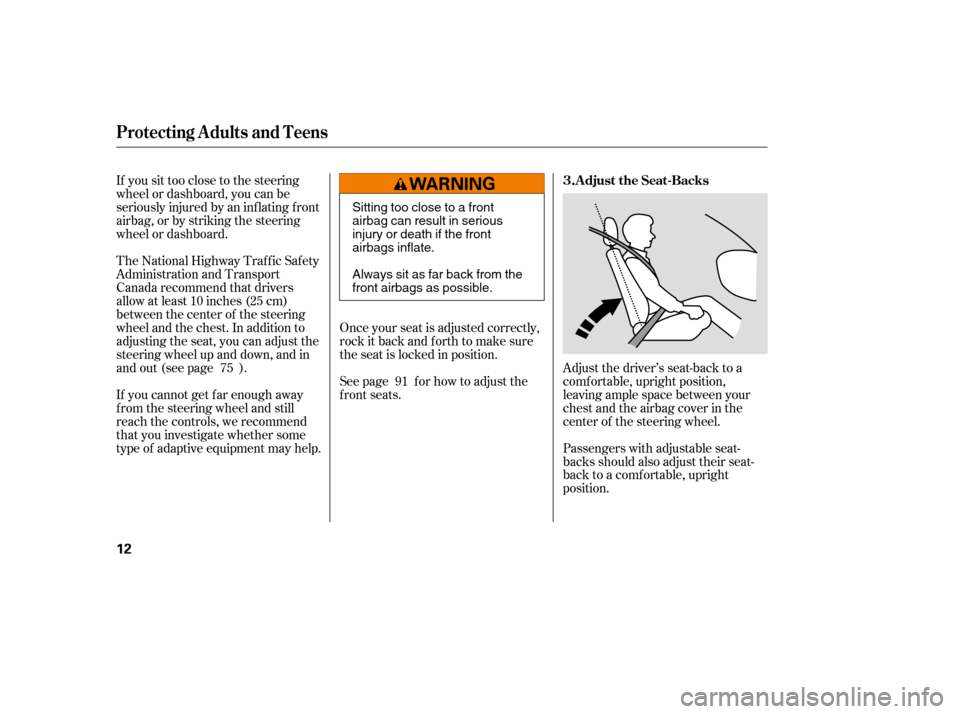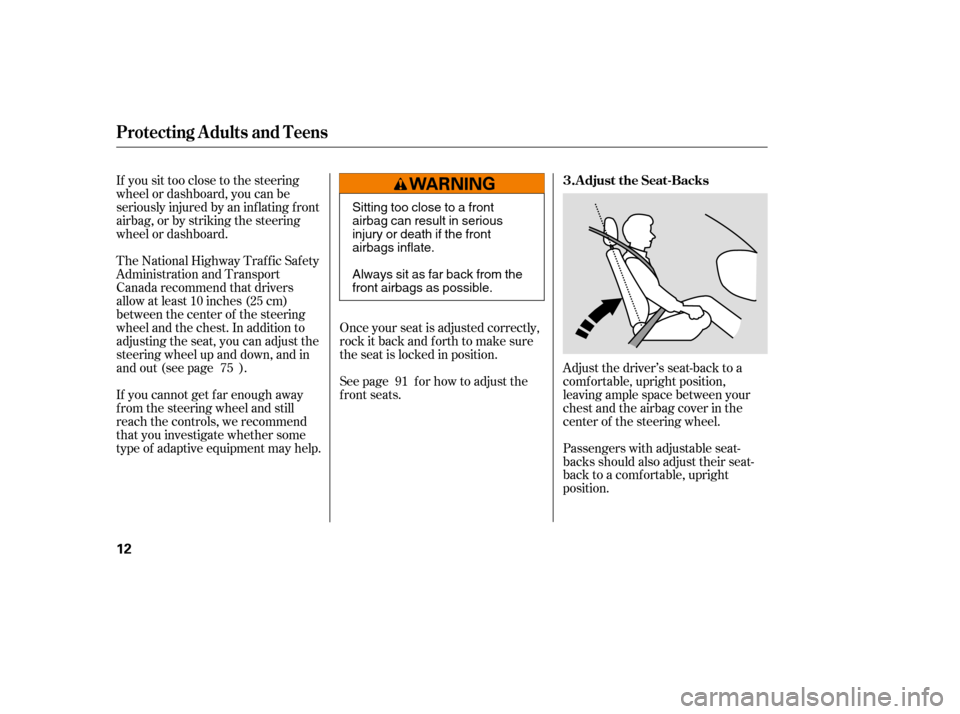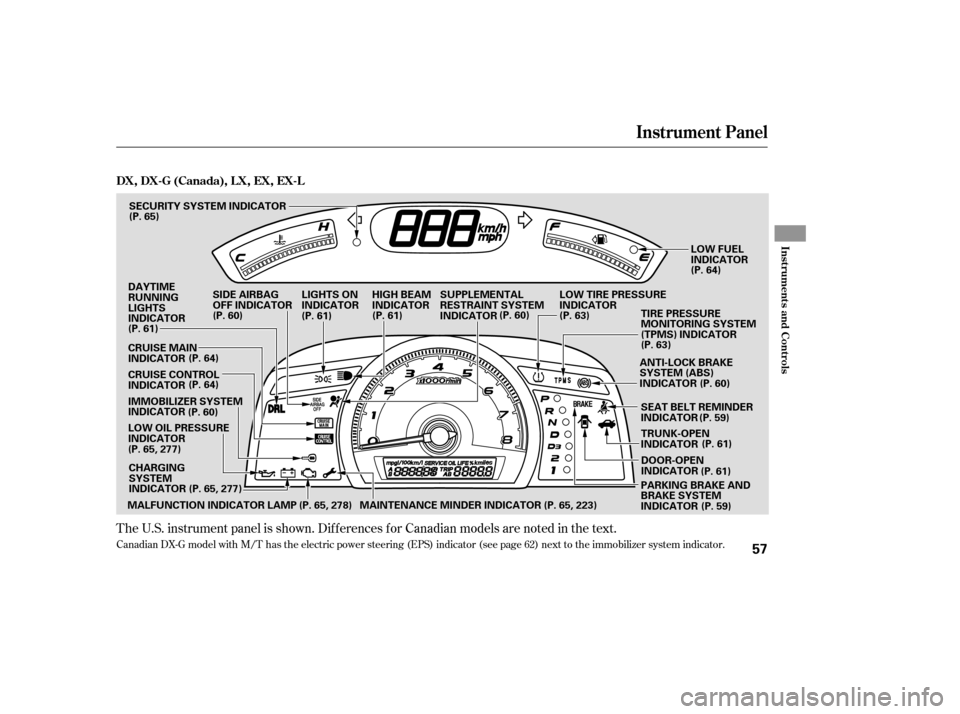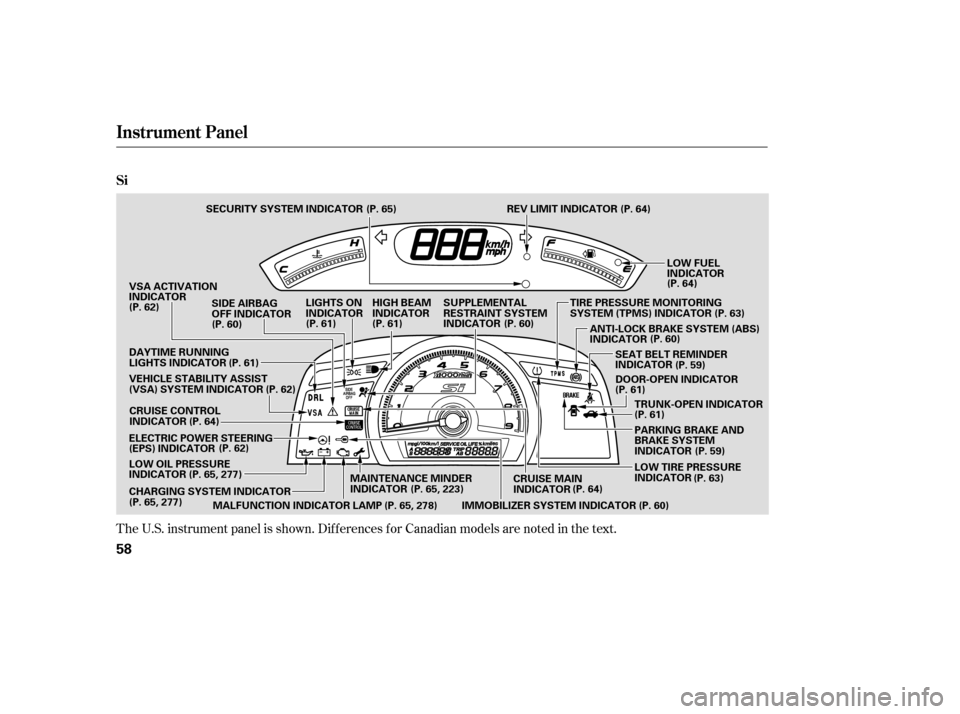Page 72 of 413

The most important things you need
to know about your airbags are:They are designed to supplement
the seat belts. Remember however, that no saf ety
system can prevent all injures or
deaths that can occur in a severe
crash, even when seat belts are
properly worn and the airbags deploy.
The rest of this section gives more
detailed inf ormation about how you
can maximize your saf ety.
Always wear
your seat belt properly, and sit
upright and as f ar back f rom the
steering wheel as possible while
allowing f ull control of the vehicle. A
f ront passenger should move their
seat as far back from the dashboard
as possible.
To do their job, airbags must
inf late with tremendous f orce. So
while airbags help save lives, they
can cause minor injuries or more
serious or even fatal injuries if
occupants are not properly
restrained or sitting properly.
Airbags do not replace seat belts. A irbags of f er no prot ect ion in rearimpact s, or minor f ront al or side
collisions. What you should do:
Airbags can pose serious hazards.
Your Vehicle’s Saf ety Features
10
�����—�����—�����y���������������y���
�(�#���������y�����
���y
Page 74 of 413

If you sit too close to the steering
wheel or dashboard, you can be
seriously injured by an inf lating f ront
airbag, or by striking the steering
wheel or dashboard.
If you cannot get f ar enough away
f rom the steering wheel and still
reach the controls, we recommend
that you investigate whether some
type of adaptive equipment may help.Once your seat is adjusted correctly,
rock it back and f orth to make sure
the seat is locked in position.
See page f or how to adjust the
f ront seats.
Adjust the driver’s seat-back to a
comf ortable, upright position,
leaving ample space between your
chest and the airbag cover in the
center of the steering wheel.
Passengers with adjustable seat-
backs should also adjust their seat-
back to a comf ortable, upright
position.
The National Highway Traffic Safety
Administration and Transport
Canada recommend that drivers
allow at least 10 inches (25 cm)
between the center of the steering
wheel and the chest. In addition to
adjusting the seat, you can adjust the
steering wheel up and down, and in
and out (see page ).
75
91 Adjust the Seat-Backs
3.
Protecting A dults and T eens
12
Sitting too close to a front
airbag can result in serious
injury or death if the front
airbags inflate.
Always sit as far back from the
front airbags as possible.
�����—�����—�����y�������������
�y���
�(�#���������y�����
���y
Page 75 of 413

If you sit too close to the steering
wheel or dashboard, you can be
seriously injured by an inf lating f ront
airbag, or by striking the steering
wheel or dashboard.
If you cannot get f ar enough away
f rom the steering wheel and still
reach the controls, we recommend
that you investigate whether some
type of adaptive equipment may help.Once your seat is adjusted correctly,
rock it back and f orth to make sure
the seat is locked in position.
See page f or how to adjust the
f ront seats.
Adjust the driver’s seat-back to a
comf ortable, upright position,
leaving ample space between your
chest and the airbag cover in the
center of the steering wheel.
Passengers with adjustable seat-
backs should also adjust their seat-
back to a comf ortable, upright
position.
The National Highway Traffic Safety
Administration and Transport
Canada recommend that drivers
allow at least 10 inches (25 cm)
between the center of the steering
wheel and the chest. In addition to
adjusting the seat, you can adjust the
steering wheel up and down, and in
and out (see page ).
75
91 Adjust the Seat-Backs
3.
Protecting A dults and T eens
12
Sitting too close to a front
airbag can result in serious
injury or death if the front
airbags inflate.
Always sit as far back from the
front airbags as possible.
�����—�����—�����y�������������
�y���
�(�#���������y�����
���y
Page 89 of 413
Two SRS (supplemental restraint
system) f ront airbags. The driver’s
airbag is stored in the center of
the steering wheel; the f ront
passenger’sairbagisstoredinthe
dashboard. Both are marked ‘‘SRS
AIRBAG’’ (see page ).
Two side airbags, one f or the
driver and one f or a f ront
passenger. The airbags are stored
in the outer edges of the seat-
backs. Both are marked ‘‘SIDE
AIRBAG’’ (see page ).
Two side curtain airbags, one f or
each side of the vehicle. The
airbags are stored in the ceiling,
above the side windows. The f ront
and rear pillars are marked ‘‘SIDE
CURTAIN AIRBAG’’ (see page).
Your airbag system includes:
2427
29
Additional Inf ormation About Your Airbags
22
(16)
(15)
(15)
(15) Side Impact Sensor (Second)
(16) Side Curtain Airbags
�����—�����—�����y���������������y���
�(�#���������y���������y
Page 132 of 413

The U.S. instrument panel is shown. Dif f erences f or Canadian models are noted inthe text.
Canadian DX-G model with M/T has the electric power steering (EPS) indicator (see page 62) next to the immobilizer system indicator.
Instrument Panel
Inst rument s and Cont rols
DX, DX-G (Canada), L X, EX, EX-L
57
LOW FUEL
INDICATOR
(P. 63) (P. 64)
IMMOBILIZER SYSTEM
INDICATOR
LOW OIL PRESSURE
INDICATOR
CRUISE CONTROL
INDICATOR
CRUISE MAIN
INDICATOR SECURITY SYSTEM INDICATOR
(P. 65)
(P. 64)
(P. 64)
(P. 60)
CHARGING
SYSTEM
INDICATOR
(P. 65, 277)
(P. 65, 277) (P. 59)
(P. 61)
DAYTIMERUNNING
LIGHTS
INDICATOR
TRUNK-OPEN
INDICATOR(P. 61)
SEAT BELT REMINDER
INDICATOR
DOOR-OPEN
INDICATOR (P. 61)
SIDE AIRBAG
OFF INDICATOR
(P. 60)
LIGHTS ON
INDICATOR
(P. 61)HIGH BEAM
INDICATOR
(P. 61) SUPPLEMENTAL
RESTRAINT SYSTEM
INDICATOR
(P. 60)
MALFUNCTION INDICATOR LAMP (P. 65, 278) MAINTENANCE MINDER INDICATOR(P. 65, 223)(P. 63)
PARKING BRAKE AND
BRAKE SYSTEM
INDICATOR
ANTI-LOCK BRAKE
SYSTEM (ABS)
INDICATOR
(P. 60)
(P. 59)
LOW TIRE PRESSURE
INDICATOR
TIRE PRESSURE
MONITORING SYSTEM
(TPMS) INDICATOR
�����—�
���—�����y�
�������������y���
�(�#���������y���������y
Page 133 of 413

The U.S. instrument panel is shown. Dif f erences f or Canadian models are noted in the text.
Instrument Panel
Si
58
LOW FUEL
INDICATOR
(P. 64)
MAINTENANCE MINDER
INDICATOR
(P. 62)
(P. 61)(P. 62)
(P. 64)
CRUISE CONTROL
INDICATOR
(P. 60)
MALFUNCTION INDICATOR LAMP
IMMOBILIZER SYSTEM INDICATORCRUISE MAIN
INDICATOR
(P. 64)
LIGHTS ON
INDICATOR
HIGH BEAM
INDICATOR
(P. 61) (P. 60) SUPPLEMENTAL
RESTRAINT SYSTEM
INDICATOR
(P. 60)
TRUNK-OPEN INDICATOR
VSA ACTIVATION
INDICATOR
DAYTIME RUNNING
LIGHTS INDICATOR
VEHICLE STABILITY ASSIST
(VSA) SYSTEM INDICATOR
ELECTRIC POWER STEERING
(EPS) INDICATOR
LOW OIL PRESSURE
INDICATOR
CHARGING SYSTEM INDICATOR
(P. 62)
(P. 65, 277)
(P. 65, 277) (P. 65, 278)(P. 65, 223) (P. 61)
(P. 61)
(P. 63)(P. 63)
(P. 60) (P. 61)
SECURITY SYSTEM INDICATOR (P. 65) REV LIMIT INDICATOR (P. 64)
SEAT BELT REMINDER
INDICATORDOOR-OPEN INDICATOR (P. 59)
SIDE AIRBAG
OFF INDICATOR
ANTI-LOCK BRAKE SYSTEM (ABS)
INDICATOR
PARKING BRAKE AND
BRAKE SYSTEM
INDICATOR (P. 59)
TIRE PRESSURE MONITORING
SYSTEM (TPMS) INDICATOR
LOW TIRE PRESSURE
INDICATOR
�����—�����—�����y������
����
���y���
�(�#���������y���������y
Page 137 of 413

If equipped If equipped
This indicator normally comes on f or
a f ew seconds when you turn the
ignition switch to the ON (II)
position.
If itcomesonandstaysonatany
other time, or if it does not come on
when you turn the ignition switch to
the ON (II) position, there is a
problem with the VSA system. Take
your vehicle to a dealer to have it
checked. Without VSA, your vehicle
still has normal driving ability, but
will not have VSA traction and
stability enhancement. See pagef or more inf ormation on the
VSA system. This indicator has three f unctions:
Itcomesonasareminderthatyou
have turned off the vehicle
stability assist (VSA) system.
It flashes when VSA is active (see
page ).
It comes on along with the VSA
system indicator if there is a
problem with the VSA system.
This indicator normally comes on f or
a f ew seconds when you turn the
ignition switch to the ON (II)
position. See page f or more
inf ormation on the VSA system. This indicator normally comes on
when you turn the ignition switch to
the ON (II) position and goes of f
af ter the engine starts. If it comes on
at any other time, there is a problem
in the electric power steering system.
If this happens, stop the vehicle in a
safe place, and turn off the engine.
Reset the system by restarting the
engine. The indicator will not turn
of f immediately. If it does not go of f
after driving a short distance, or
comes back on again while driving,
take the vehicle to your dealer to
have it checked. With the indicator
on, the EPS may be of f , making the
vehicle harder to steer.
1. 2. 3.
210 210
210
Instrument Panel Indicators
Vehicle Stability Assist
(VSA ) System Indicator VSA A ctivation Indicator Electric Power Steering
(EPS) Indicator
Si and Canadian DX-G with manual
t ransmission models
62
�����—�
���—�����y�
����
����
���y���
�(�#���������y���������y
Page 138 of 413

If you turn the steering wheel to the
f ull lef t or right position repeatedly
while stopping or driving at very low
speed, you may f eel slightly harder
steering due to overheating of the
steering gear box.This indicator normally comes on f or
a f ew seconds when you turn the
ignition switch to the ON (II)
position.
If this indicator comes on and stays
on at any other time, or if it does not
come on when you turn the ignition
switch to the ON (II) position, there
is a problem with the TPMS. With
this indicator on, the low tire
pressure indicator will not come on
when a tire loses pressure. Take the
vehicle to your dealer to have the
system checked.
This indicator normally comes on f or
a f ew seconds when you turn the
ignition switch to the ON (II)
position.
If it comes on while driving, it
indicates that one or more of your
vehicle’s tires are signif icantly low
on pressure.
If this happens, pull to the side of the
road when it is saf e, check which tire
has lost the pressure, and determine
the cause. If it is because of a flat tire,
replace the flat tire with the compact
spare (see page ), and have the
f lat tire repaired as soon as possible.
If two or more tires are underinf lated,
call a prof essional towing service
(see page ). For more
inf ormation, see page .
267
286 212
U.S. models only
U.S. models only
Instrument Panel Indicators
Tire Pressure Monitoring
System (T PMS) Indicator
Low Tire Pressure
Indicator
Inst rument s and Cont rols
63
�����—�����—�����y���������������y���
�(�#���������y���������y